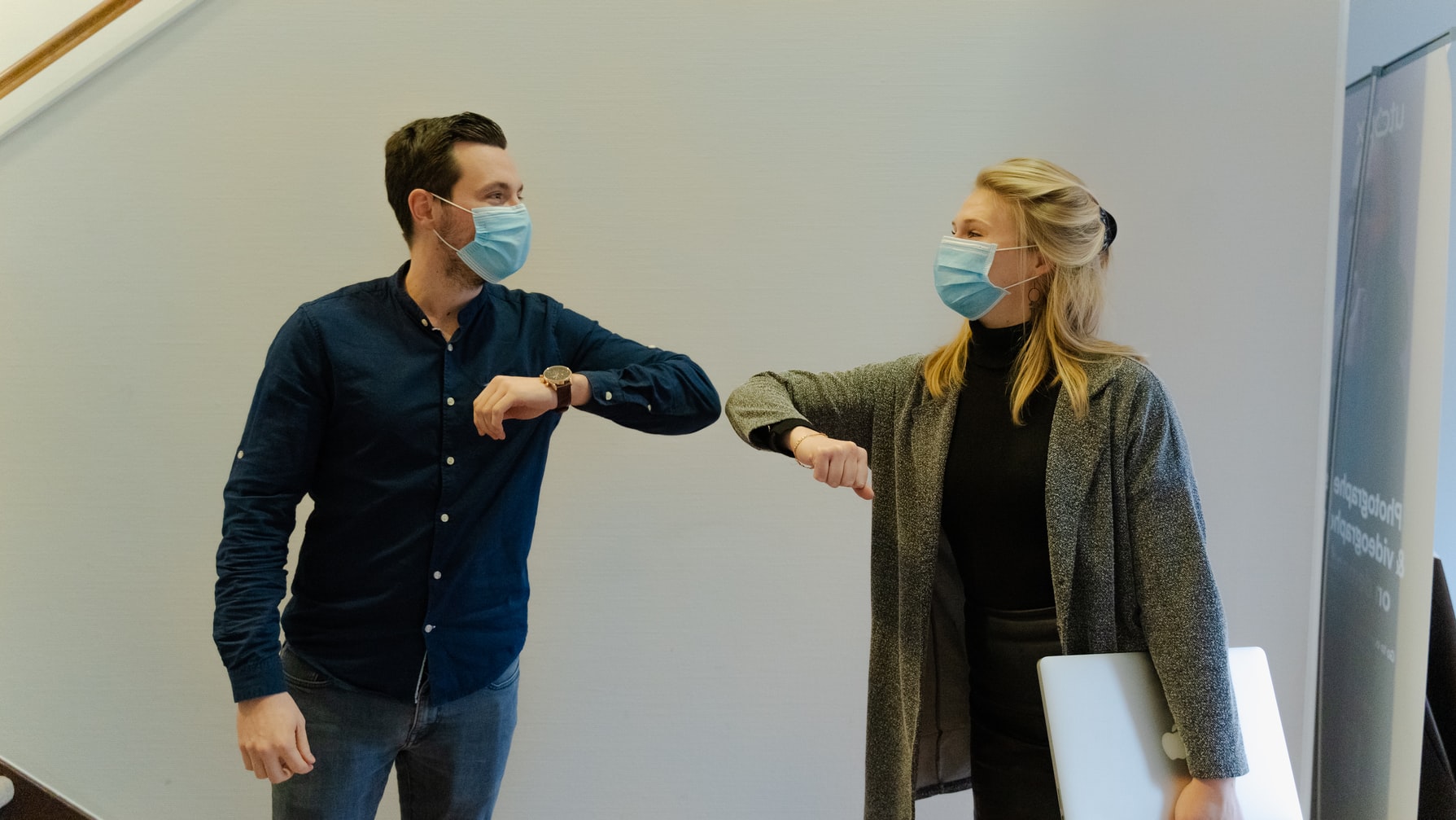BLOG
COVID fatigue | Keeping staff engaged with your health and safety controls

Having lived with coronavirus for over a year, it’s understandable that some may have become tired of constant COVID precautions. And with the successful vaccine rollout, marked decline in infection rates and subsequent relaxation of lockdown restrictions, there may be the illusion that it’s ‘business as usual’.
However, the coronavirus threat hasn’t gone away. As the Prime Minister said when announcing the roadmap out of lockdown, there is “no credible route to a zero-COVID Britain or a zero-COVID world”. In other words, the virus is here to stay, and we have to accept it as a hazard we will need to live with and manage. In fact, despite positive strides to contain the virus domestically, new, even more contagious versions of the virus are being found across the globe.
As such, while a return to ‘normal’ feels tantalisingly close, it is critical that your workforce remains engaged with the measures you have in place to control the risk of COVID-19 transmission, particularly as lockdown restrictions are gradually repealed and businesses open more widely, with more visitors, more activities and more opportunities for person-to-person contact. Indeed, health experts are reminding everyone of the need to stick to the safety precautions, and it’s important that businesses lead the way.
The growing problem of 'COVID fatigue'
Speaking to employers on a daily basis, it’s clear that keeping employees engaged with COVID-19 control measures is proving to be a growing challenge. It’s perhaps not surprising; sticking at any form of new habit over a prolonged period can be tough.
So-called ‘COVID fatigue‘ – also referred to as ‘behavioural fatigue’, ‘pandemic fatigue’, ’emergency fatigue’, ‘public fatigue’ and ‘adherence fatigue’ – is a perfect example how difficult widespread behavioural change can be. Many can attest that it is relatively easy to begin making lifestyle changes such as quitting smoking or starting an exercise regime, but over the long term, maintaining this momentum and applying yourself with the same vigour that you started with can be difficult.
The psychological explanation behind COVID fatigue is twofold:
- Fear, which initially acts as a motivator for protective behaviour, eventually wears off as people adapt to the threat.
- Coupled with this, fatigue also occurs when we do the same things repeatedly for a long time.
That’s not to say that longer-term adaption is impossible. Seat belts didn’t become a legal requirement for rear passengers until 1987; the use of children’s car seats wasn’t made mandatory until 2006; and despite the dangers of second-hand smoke, the ban on smoking in enclosed public spaces didn’t happen until 2007. Now that we understand the risks, these precautions are accepted as the norm. In fact, it’s strange to think of a time when they didn’t exist.
The same can be said of COVID-19. Wearing a mask, counting to 20 while washing your hands, and keeping a two-metre distance from those outside of our household or bubble have all become part of our now-adapted daily lives. That said, standards can begin to slip and complacency can creep in – if this is something you have noticed within your workplace, it may be as a result of COVID fatigue.
Perhaps employees aren’t as diligent about hand hygiene or your cleaning routine as they once were. Maybe they are taking shortcuts to make life easier, such as becoming lax with social distancing or not wearing masks correctly. If your workers become less vigilant, an increase in positive COVID-19 tests is likely to follow; you will then face the issue of workers needing to self-isolate, which can really impact on your business. Above all, there is a real risk of severe illness that both you and your employees have a collective duty to prevent.
Indeed, the Health and Safety at Work etc Act 1974 places a legal duty on employers to ensure, so far as is reasonably practicable, that employees and others are kept safe, as well as a legal duty on employees to take reasonable care of the health and safety of themselves and others and cooperate with their employer.
With this in mind, now’s the time to re-engage your workforce. So how can employers encourage adherence to COVID-19 controls, even when staff are fatigued?
Related Content
Do you need support?
Speak to us for an honest, no obligation chat on:
0345 226 8393 Lines are open 9am – 5pm

6 ways to keep employees engaged with your COVID controls
Keep risk assessments under regular review.
Do your employees understand your controls? Are they continuing to follow them as intended? Are managers leading by example? Observing the working environment against what’s written in your risk assessment, and talking with employees, may provide helpful insight into what is working well and what could be done better. It could also help you to understand what, if anything, is preventing employees from adhering to any of the measures you currently have in place.
Make sure managers lead the way.
People typically take their lead from others. When everyone’s got their mask under their chin and chatting elbow to elbow, it’s natural to feel silly being the only one stood back with a mask fully on. To counter fatigue and prevent bad habits from creeping in, make sure supervisors / team leaders commit to being the example-setter, not the group-follower, and correcting behaviours that aren’t COVID-safe.
Communicate findings from observations/inspections.
Share your observations to help employees understand what they are doing incorrectly, then explain the right way. Similarly, praise examples of good practice.
Avoid shaming workers into PPE compliance, as this can make them hide unsafe behaviour, add to stress/fatigue and cause people to become even more disengaged, though if they repeatedly fail to adhere to these measures despite reminders, disciplinary action may be necessary to prevent putting others at risk and show that you are taking safety seriously. Support adherence by making sure PPE is easy to find; if workers can’t find a mask, it’s an extra step to go and look for one, so keep necessary supplies at hand to prevent unnecessary barriers (or excuses).
Consider a buddy system.
More PPE training is unlikely to address PPE fatigue. Instead, consider a worker “battle-buddy” system. Originally created by the US Army, the system focused on ensuring soldiers always had someone watching their metaphorical back, but the same concept can be applied to shore-up worker adherence to COVID-19 controls. For things to work, both “buddies” must to commit to speaking up and not letting their colleague expose themselves unnecessarily.
Educate.
There is often a misconception that being vaccinated or previously having COVID-19 means it is unnecessary to follow control measures. Messaging needs to highlight and reinforce that this is not the case and that social distancing and other risk mitigation controls still need to be followed to keep everyone safe. Reinforce the ‘us’ rather than ‘me’ mentality, share credible sources, and consider whether refresher training might help to remind and re-motivate your team.
Ask what more you could do as an employer.
Are you doing all you can to enable people to comply with the rules? According to one study, a crucial area of behaviour where adherence is low is self-isolation, with only around 20% of people taking this crucial measure when they have symptoms. Make sure that your culture or practices don’t put pressure on people to come in when potentially infectious (not least because knowingly allowing a COVID-positive employee to attend he workplaces is a legal offence, with fines starting at £1,000).
Similarly, with a quarter of employers not implementing social distancing in the workplace, and 17% of safety reps reporting that they were not aware that a risk assessment of their workplace in the last two years, it is prudent to reflect on where you might be falling short as an employer. After all, if safety measures aren’t in place, not only can people not follow them, but they are more likely to take the view that compliance isn’t all that important.
All of this comes down to your overall ‘safety culture’. The key to developing a good safety culture? Keep emphasising the importance of safety precautions until good habits become second nature and COVID precautions become ‘hardwired’. In other words, lead from the top.
In this way, rather than seeing COVID fatigue as a problem of individual compliance, consider that it may be symptomatic of the organisation itself.
Health & Safety Training Manager, A Smith Gt. Bentley Ltd
We're available now
If you feel out of your depth when it comes to health and safety management, Ellis Whittam’s fixed-fee service is the perfect solution. From an initial compliance audit to dedicated consultant support and easy-to-use risk management software, we can help to transform your approach to risk management and work with you to raise standards across your organisation.
To find out more about our hands-on support from UK employers, call 0345 226 8393 or request your free consultation using the button below.
Sign up for the latest news & insights
Resources
Latest News & Insights

Work from wherever? | Things to consider before allowing employees to work from abroad
BLOG Written by Alexandra Farmer on 25 May 2022 A few years ago, the idea of working from anywhere in the world seemed like a pipe dream.

Reduced workforce? Here’s 5 health and safety areas you need to revisit
BLOG Written by Charles Spencer on 18 May 2022 In 2022, a growing number of businesses have moved, or are in the process of moving,

Fee for Intervention | Why health and safety breaches could cost your business more in 2022
BLOG Written on 16 May 2022 It’s a well-known fact that poor health and safety practices cost businesses money. And with the HSE recently announcing yet another

Remote work isolation | How employers can help combat loneliness
BLOG Written on 12 February 2021 While the benefits of remote work are seemingly boundless, often overlooked is the isolation and disconnectedness that it can

Time off for getting married or moving house
BLOG Written on 12 May 2022 There are certain big life events that can sometimes get in the way of work. Whether it’s a wedding

Recent cases highlight continued work at height failings
BLOG Written on 6 May 2022 Working at height continues to be the leading cause of work-related fatality. According to most recent HSE figures, these

Managing organisational change | How to keep people happy
BLOG Written on 28 February 2022 In the direst of circumstances, humanity’s true capacity for adaptation and perseverance can be realised. Where the business world

5 ways to combat 2022’s recruitment challenges when you can’t pay more
BLOG Written by Christian Vincent and Hannah Copeland on 15 April 2022 In 2022, recruitment and retention are fast becoming employers’ biggest challenges. With people

A war of words | Managing employees’ political views on the Russia-Ukraine conflict
BLOG Written by Lesley Rennie on 13 April 2022 The war in Ukraine, and the daily news reports of fatalities, continues to spark conversation in






